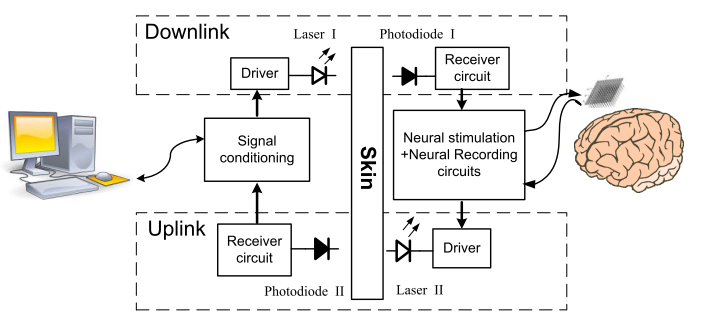IC design for an Optical Transcutaneous Telemetric Link
In recent years, brain machine interfaces enable scientists to observe and record neural activity. In some cases neural stimuli can also be applied to partially restore lost neural functionality. Such interfaces require means of bidirectional wireless communication between the brain implant and the outside world without the risk of inflammation. In state of the art RF communication is mostly used. Although RF links are capable of achieving high data rates, they also suffer from high absorption of skin in the GHz range. One major issue of RF bio-telemetry is the cross talk between the inductive power link and the RF data telemetry. Such a system requires sophisticated encoding schemes and orthogonal alignment between the data and power coils to avoid interference. Optical communication is an attractive alternative since it provides a low interference solution for transcutaneous communication and is also capable of high data rates.
We are developing an IC capable of achieving a bidirectional optical transcutaneous telemetric data link for brain machine interfaces using wavelength division multiplexing (WDM). By converting the digitized electronic signals to a stream of infrared and visible optical pulses, the optical telemetry wirelessly transmits data between the implanted neural recorder/stimulator and the external control devices. A near infrared VCSEL with a peak wavelength of 850 nm is utilized in the uplink for data transmission from the implants to the external device. The uplink is capable of high data rates of tens of Mbps which is required because data from neural signals are recorded in parallel on hundreds of electrodes.
A photodiode based receiver with a peak wavelength of 650nm is utilized in the downlink to transmit data from the external base unit to the implant. Here depending on the application the required data rate is typically lower than 1Mbps. By selecting two different wavelengths for the transmitter and the receiver and using an optical filter, a minimal level of interference is achieved. This also helps to keep the implant size small while simultaneously using the power efficient optical link.

Projektleiter
Projektmitglieder
Dr.-Ing. M. Haas
